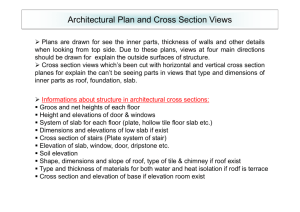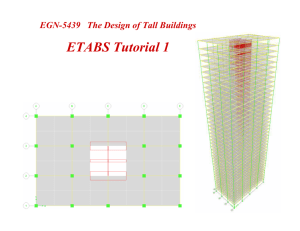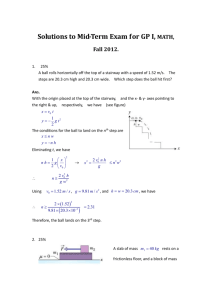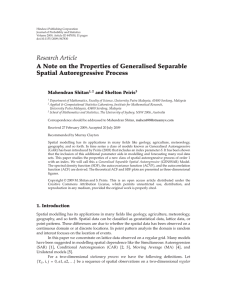final - An-Najah National University
advertisement
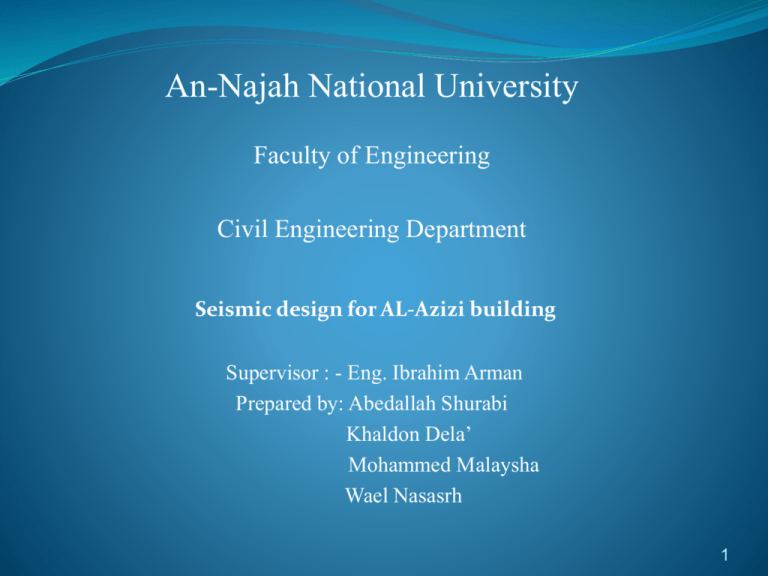
An-Najah National University Faculty of Engineering Civil Engineering Department Seismic design for AL-Azizi building Supervisor : - Eng. Ibrahim Arman Prepared by: Abedallah Shurabi Khaldon Dela’ Mohammed Malaysha Wael Nasasrh 1 Outline Abstract Project description Slab design Beam design Column design Footing design Shear wall design Stairs design 2 Abstract Al-Azizi Building represents the most common building in Nablus. A one way ribbed slab structural system will be analyzed and designed for seismic load, then a flat plate structural system analyzed and designed for same purpose, In the end an economic comparison between two designs will be made. As a result, a recommendation will be given for the most economic system. 3 Project description Consist of six floors The area of the base floor is 766m2 The height of the first floor is 6m The area of the rest floors for each one is 760m2 The height of the rest of floors for each one is 3.4m 4 5 Codes and standards: ACI 318-08 IBC 2006 ASCE 7-10 SI 413 (Israeli standards) 6 Loads affecting the building 1-Gravity loads: The superimposed dead load is 4.3KN/m2 The live load for basic floor is 2.5 KN/m2 The live load for the balcony is 5KN/m2 The Dead Load Calculated By SAP 2000 7 Loads affecting the building 2-Lateral loads: Seismic map of Palestine 8 Loads affecting the building 2-Lateral loads: The seismic zone factor, Z = 0.2 The soil type is soft limestone, soil class C The importance factor, I = 1 The ductility factor, R = 5(One way ribbed slab) The ductility factor, R = 3(Flat plate slab) The system over strength , Omega = 3(both systems) Deflection Amplification , Cd = 4.5 (One way ribbed slab) Deflection Amplification , Cd = 2.5 ( Flat Plate slab) 9 Loads affecting the building 2-Lateral loads: The spectral acceleration coefficients : SS = 2.5*Z = 0.5 S1 = 1.25*Z = 0.25 10 One way ribbed slab Slab thickness: Slab thickness =6. 15/18.5=0.33m (assume 0.36m) 11 Cross section in rib 12 Typical floor framing plan 13 Check shear for slab: ΦVc = 25 KN Vu= 20.97 KN Vc>Vu ok 14 Shrinkage steel for slab: As = 0.0018*b*d As = 0.0018*1000*60 = 141mm2 Use 3 Ø 8 /m 15 Three Dimensional Analysis and design Gravity Load Define load patterns Seismic Load 16 Response spectrum function 17 Checks 1) Compatibility Check 18 2) Equilibrium Check 1.Superimposed Dead Load By Hand 4.3*4555.8=19589.94 KN By SAP =18762.089 KN % of Error =4.41% < 5% ...OK 19 2) Equilibrium Check 2. Live Load By Hand Basic floor = 2.5*4155.12=10387.8KN Exterior balconies =5*400.68=2003.4KN By SAP = 11909.947 KN %error = 4%<5% OK 20 2) Equilibrium Check 3. Dead load By Hand=56742. 58KN By SAP =54455.45KN % error=4.2% < 5% ok 21 3)Seismic check Base shear 1) V = Cs W = 4822.84KN (By Hand) V = 4823.29 (By SAP) We have Error = 0.0093% < 5% OK 2) Time period T=Ct*hnx =0. 04666*230.9=0.7843 Sec 22 Slab Analysis: Moment diagrams for slab Bending moment for first slab in X-direction Bending moment for first slab in Y-direction 23 Beam details 24 Column Data The project consists 64 columns with different dimensions and directions 1% ≤ steel ratio ≤ 8% for economic consideration Lateral reinforcement for columns Spacing So shall not exceed the smallest of : 25 Column Reinforcement Column Section(cm) Longitudinal reinforcement C1 C1` C2 C3 C4 C5 C6 C7 C8 30*50 30*50 30*90 40*60 60*40 40*80 40*100 100*40 30*70 8 Φ16 10 Φ20 14 Φ16 12 Φ16 12 Φ16 16 Φ16 20 Φ16 20 Φ16 12 Φ16 Lateral reinforcement At the middle At the end 1 Φ10/16 1 Φ10/12 1 Φ10/16 1 Φ10/12 2 Φ10/16 2 Φ10/12 2 Φ10/16 2 Φ10/12 2 Φ10/16 2 Φ10/12 2 Φ10/16 2 Φ10/12 2 Φ10/16 2 Φ10/12 2 Φ10/16 2 Φ10/12 2 Φ10/16 2 Φ10/12 26 27 Footing analysis and design Type of footing: First the expected area of footing calculated as follows Σ Pservice / qall.= 110030.5 / 250 = 440.122 m2 The ratio of area calculated to the plan area = (440.122 / 750) 100 % = 58.69 % > 50 % Based on this result a mat foundation selected. 28 The depth of footing “h “ We assume d= 700 mm and h = 800 mm for mat foundation Thickness checks: 1. Wide beam shear check ɸ Vc = 0.75 * 280.5 * 1000 * 700 / 6 * 1000 = 463 KN From SAP Vu = 432 KN < 463 KN OK 29 2) Punching shear check ɸ Vc = 0.75 * 280.5 / 3 = 1.322 MPa This value compared with stress for column as shown in Table 1, from the table all the results are ok so the punching is ok. 30 Check q (Bearing Capacity) qall = 250 KN/ m2, seismic service load used to check because it is the critical case, Table 2 shows the results of a sample reading for the check. 31 Mat Foundation Design 32 33 34 Check slab thickness From the architectural plan the maximum span length L = 6.15m Hmin1 = (6.15-0.2-0.15) /33 = 0.176 m Assume slab thickness h = 0.2 m and d = 0.16 m Wu slab = 1.2* (5 + 4.3) + 1.6 (2.5) = 15.16 KN/m2 Wu balcony = 1.2 (5 + 4.3) + 1.6 (5) = 19.16 KN/m2 35 Check slab thickness - Check for wide beam shear ΦVC =98 KN Vu slab =41.54 KN < 98 KN OK Vu balcony = 52.5 KN < 98 KN OK Check punching shear Vc= 0.33 fc0.5 = 1.616 MPa Vu= 1152.62/1000 KN/m2 = 1.15 Mpa Vn = Vu / ɸ = 1.15/0.75 = 1.53 < 1.616 OK So there is no need for reinforcement for punching shear. 36 Equilibrium check 1.Superimposed Dead Load Hand calculation = 4.3 * 4555.8 = 19589.94 KN By SAP = 18762.08 KN % of difference = 4.41 % < 5 % OK 37 Equilibrium check 2. Live load By Hand Basic floor = 2.5*4155.12=10387.8KN Exterior balconies =5*400.68=2003.4KN Total = 12391.2 KN By SAP = 11909.94 KN % of difference =4% < 5 % OK 38 Equilibrium check 3. Dead load By hand= 39745.83 KN By SAP = 41639.16 KN % of difference =4.54% < 5% OK 39 Bending moment for first floor slab in X-direction m11 Bending moment for first floor slab in Y-direction, m22 40 Beam reinforcement Beam Dimensions(mm) Bottom steel Top steel Top steel Shear reinforcement Shear reinforcement Left Right Middle end A 250*750 6ɸ14 5ɸ14 5ɸ14 1ɸ10/100mm 1ɸ10/100mm B 250*750 6ɸ14 10ɸ14 5ɸ14 1ɸ10/100mm 1ɸ10/100mm C 250*750 7ɸ14 5ɸ14 8ɸ14 1ɸ10/100mm 1ɸ10/100mm D 250*750 7ɸ14 7ɸ14 6ɸ14 1ɸ10/100mm 1ɸ10/100mm E 400*350 4ɸ14 4ɸ14 5ɸ14 1ɸ10/100mm 1ɸ10/100mm 41 Column reinforcement Column Section(cm) C1 C2 C3 C4 C5 C6 C7 C8 30*40 30*60 30*70 30*80 30*90 40*90 40*110 110*40 Longitudinal reinforcement 4 Φ20 6 Φ20 8 Φ20 8 Φ20 10 Φ20 12 Φ20 14 Φ20 14 Φ20 Lateral reinforcement 1 Φ10/300 2 Φ10/300 2 Φ10/300 2 Φ10/300 2 Φ10/300 2 Φ10/300 2 Φ10/300 2 Φ10/300 42 Footing analysis and design Type of footing: First the expected area of footing calculated as follows Σ Pservice / qall.= 106811.3/ 250 = 427.25 m2 The ratio of area calculated to the plan area = (427.25 / 750) 100 % = 57 % % > 50 % Based on this result a mat foundation selected. 43 The depth of footing “h “ We assume d= 600 mm and h = 700 mm for mat foundation Thickness checks: 1. Wide beam shear check ɸ Vc = 0.75 * 280.5 * 1000 * 600 / 6 * 1000 = 397 KN From SAP Vu = 370.42 KN < 397 KN OK 44 Punching shear check ɸ Vc = 0.75 * 280.5 / 3 = 1.322 MPa This value compared with stress for column as shown in Table 1, from the table all the results are ok so the punching is ok. 1. 45 Check q (Bearing Capacity) qall = 250 KN/ m2, seismic service load used to check because it is the critical case, Table 2 shows the results of a sample reading for the check. Sample number Location P service Area Q 1 Corner 15 .0625 240 < 250 OK 2 Center 50 .25 232 < 250 OK 3 Edge 29 .125 200 < 250 OK 46 Mat Foundation Design 47 48 Shear wall design CSI column program used to design the shear wall; the loads used for design are taken from SAP. We assume Longitudinal reinforcement 1 Φ28/35 cm 49 Shear wall transverse reinforcement Transverse reinforcement in x-direction(2ɸ12/10 cm) Transverse reinforcement in y-direction(2ɸ12/10 cm) 50 Stairs design Stairs details Concrete unit weight = 25KN/m³ fc = 28Mpa Fy=420Mpa Live load = 5 KN/m2 Superimposed dead load = 3 KN/m2 51 hmin = (1.1+2.7)/20 = 0.2m Rise = 0.16 m and run = 0.3 m Loading (Flight) Wu = 20.8*1.45 = 30.16 KN/m Loading (Landing) Wu = 17.6*1.55= 27.28 KN/m 52 Check For Shear Vu = 77.904 KN ɸVc = ((0.75/6)240.5(1450*160)/1000) = 142 KN> 77.904 KNOK 53 Mu = 106.54 KN.m ρ = 0.006899 >ρmin = 0.00333 OK As = 0.006899 *1450*160 = 1600.56 mm2 (8Φ16) For shrinkage reinforcement = 0.0018*1000*200 = 500 mm2 (1Φ10/15cm) 54 Stairs details 55 Comparison between two systems 56 Comparison between two systems Comparison items Slab 1-Thickness 2- Own weight 3-Concrete volume 4-Concrete weight for meter square 5-Steel weight 6-Reinforcement Beams 1-Dimensions(L,W,D) 2-Concrete volume 3-Steel weight Columns 1-Dimensions(L,W,D) 2-Concrete volume 3-Steel weight One way ribbed system Flat plate system 36cm 6KN/m2(per rib) 1.4 cubic meter 1.7KN/m2 20cm 5KN/m2 4.12 cubic meter 5KN/m2 156.5kg T2ɸ12/B2ɸ12(Per rib) 300.5kg T4ɸ12/B4ɸ12(In x and y directions) (6.2X.7X.36),(6.2x.9x.36) (4.2x.9x.36),(4.2x.4x.36) m 5.56 cubic meter 515.42kg (6.2x.25x.75),(6.2x.25x.75) (4.2x.25x.75)m (3.4x.3x.9),(3.4x.4x.8) (3.4x.4x.6)m 3.74 cubic meter 321.14kg (3.4x.3x.4),(3.4x.3x.7) (3.4x.3x.5),(3.4x.3x.55)m 2.19 cubic meter 205.7kg 3.11 cubic meter 211.17kg 57 Comparison between two systems 58 59


